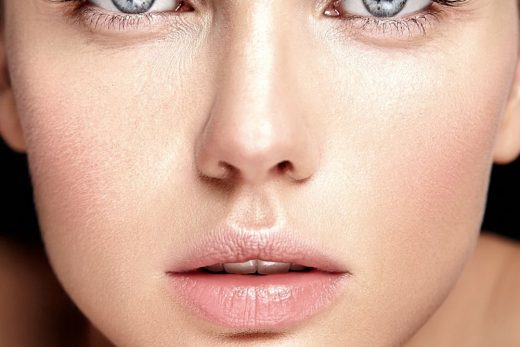What is light therapy?
“Light therapy, or LED treatments have been around for over 30 years and were originally developed for astronauts to help with tissue healing and repair,” explains Dr. Zamani.
According to dermatologist Dr. Dennis Gross, the benefits of LED light therapy are manifold. They include treating acne, regulating natural oil production, stimulating collagen and elastin and minimising redness and wrinkles. Certain wavelengths have even been shown to reduce dark spots and uneven skin tone.
As the spectrum of light used does not include UV, there’s no risk of damage – and no, you won’t get a tan.
How does light therapy work?
“LED therapy uses light in the visible spectrum – including blue, yellow, amber and red – as well as light beyond the visible spectrum to penetrate different depths of skin. As the light wavelength increases, so does the depth of penetration,” explains Dr. Gross. This light is absorbed by receptors in the skin, just like topical skincare, and each colour of light stimulates a different response in the skin. LED is suitable for use on all skin types and tones.
How to use an LED tool at home
Today, there’s a small but growing list of options when it comes to at-home light therapy devices. For a complete facial treatment, an LED mask is the most obvious investment, but the emergence of targeted ‘wands’ and smaller (more portable) treatment lights is especially interesting for treating areas of acne-prone skin.
As LED treatments deliver cumulative results, commitment is key. As Debbie Thomas, laser aesthetician and celebrity facialist says, “just owning a device won’t give you any results.”
While instructions will vary depending on the device you choose, LED treatments are usually light on labour. “The good thing about LED masks is they are pretty simple to use and generally only need around 10 minutes of dedicated time,” explains Thomas. While a mask offers more ‘slip on and relax’ appeal, “wand devices are designed to be held over your skin for 20-30 mins, so it’s normally a toss-up between an aching arm or boredom that leads a dedicated skin warrior to fall out of love with their new skin gadget.”
What colour LED do I need?
RED
The majority of at-home LED masks offer a red light setting. At the lighter end of the spectrum, red light works to soothe inflammation and redness, while deeper shades penetrate the skin further to prompt cellular repair and circulation, resulting in a plumper, more vibrant complexion.
BLUE
This antibacterial light is used to kill the bacteria that leads to breakouts, making it ideal for treating acne-prone skin. Blue light also helps purify the skin and regulate oil glands.it’s commonly combined with red light in at-home devices, and can often be found in targeted pens, which are ideal for bringing down breakouts.
AMBER
Less common in at-home devices, this colour works to revitalise the skin, reducing any swelling and increasing radiance.
INFRARED
Invisible to the naked eye, this light penetrates deeper than any other colour in the spectrum. It combats the signs of ageing by replenishing dermal and epidermal cells, stimulates the natural production of collagen and elastin, and speeds up the recovery process. You’ll find near-infrared light in the most advanced at-home LED masks.





